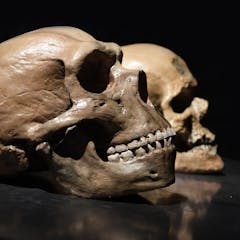
Articles on Brain
Displaying 61 - 80 of 579 articles

People with aphantasia are unable to deliberately bring to mind mental images. Understanding the mechanisms of aphantasia reveals that different types of cognition exist.

Pinpointing where memories are stored in the brain and how they are transmitted could provide new targets to treat neurological diseases and serve as models for neuromorphic computing.

Learning new rules requires the suppression of old ones. A better understanding of the brain circuits involved in behavioral adaptation could lead to new ways to treat schizophrenia and bipolar disorder.

We often feel drained of energy after a long day of work or study. Here’s how we measure what’s going on in our brain.

Collections of self-organising nanowires behave a lot like the neurons and synapses in our brains, with startling results.

Neuroscientists have typically thought of energy supply to the brain as demand-based. A supply-limited view offers another perspective toward aging and why multitasking can be difficult.

But it could still save you from dementia.

Organ models that more accurately capture finer details could reduce surgical error and lead to personalized implants.

Parents provide the energy needed for their young to grow large brains. Climate change may negatively affect birds’ brain development as it impacts food supplies.

A new film changes its story based on the emotions expressed by the viewer.

Music, memories and emotions are all linked and certain songs can act as a direct line to our past.

We live in a world where we frequently do not get enough sleep, but we need sleep if our brains are going to stay healthy and function efficiently.

By learning what parts of the brain are crucial for imagination to work, neuroscientists can look back over hundreds of millions of years of evolution to figure out when it first emerged.

Studies show that contact with nature reduces the activity of the amygdala, a region of the brain linked to intense emotions, stress and anxiety.

Spontaneous trips down memory lane: why and how the mind wanders.

In birds, big brains aren’t associated with living in large social groups – instead, they’re linked to long stints of parental feeding.

Using a new equation based on today’s primates, scientists can take a few molar teeth from an extinct fossil species and reconstruct exactly how fast their offspring grew during gestation.

A new neuropsychology study on California wildfire survivors found chronic cognitive problems in addition to anxiety and PTSD.

The way human brains develop is special – but not quite as special as you’d like to think, if we consider Neanderthals as well.

An 18-month treatment with lecanemab slows functional and cognitive loss by 27 per cent in people with mild Alzheimer’s disease. But this is only the first step towards a real cure.
